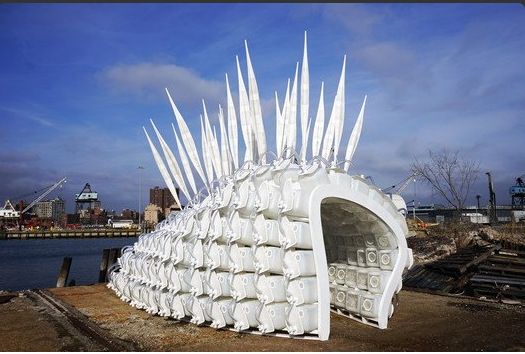A Navy Yard Firm Has Created A Pod/Farm That Harnesses Crickets As A Means Of Survival

The Navy Yard is being reborn as an innovation center and one firm thinks bugs are the future.
Terreform Open Network Ecology (63 Flushing Avenue, Unit 192), an urban innovation and tech think tank, has created prototypes of cricket-breeding pods meant to ensure man’s survival of major disasters by providing shelter and sustenance in dire situations.
“It’s a combination of an emergency shelter and a vertical farm but it’s also a clever, sanitary way to bring insect-based protein to fine cuisine,” said co-founder Mitchell Joachim to CNN.

CNN reports:
The articulated modular structure consists of an arched CNC plywood frame and 264 plastic rectangular insect pods — or homes — that slot into the frame, stacked one on on top of another.
If a natural disaster should strike, the shelter’s prefabricated design could be swiftly produced, delivered and erected on site. Its shell would provide both protection from the elements and a sustainable farming system which could produce high-protein nutrition in devastated areas.
The pod was inspired by the need to respond to the many problems posed by climate change, including potential weather and food crises, reports the Daily Mail. The firm’s website explains how the structure could be cheaply, easily built and reproduced as needed, which is a benefit in the resource-constrained world that Terreform ONE sees the pod inhabiting.
For now, the idea is to turn the crickets into a protein-rich flour that can be used as the basis for other foods, reports WPIX 11.
One interesting note is that the pods are said to amplify the noise of the crickets, one side effect of what Joachim calls their “fabulous” design, according to CNN. There’s no word on if Terreform ONE has a place for the bees that recently lost their home in Fort Greene.
However, given the revolutionary nature of the design of this project, I’m sure we’ll hear more than just… crickets about this in the future.



